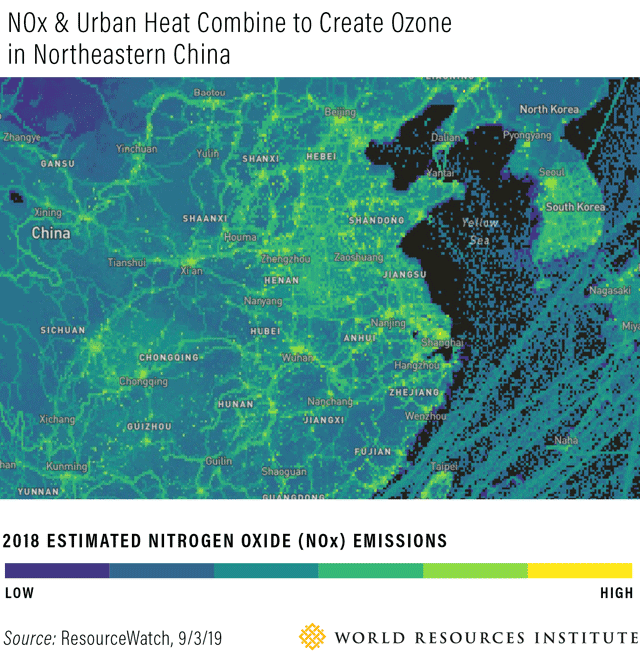
Summertime often means soaring, dangerous temperatures. Recent heat waves in Europe brought government warnings, power plant shutdowns, restrictions on automobile use, heat stroke and deaths. But misery in Europe and elsewhere is compounded by the chemistry of how emissions from things like cars and air conditioners combine with the urban heat island effect to create zones of poor air quality. Striking examples of this phenomenon can be seen in many cities around the world, including across northeast China, where dense cities and heavy industry contribute to almost year-round unhealthy air quality.
The urban heat island effect is a result of urban development practices that on one hand increase absorption of solar radiation in a city, through darker and more impermeable surfaces, and on the other hand decrease natural heat-mitigating features like trees, greenspaces and water. But cities also generate nitrogen oxides (NOx) when burning fossil fuels for activities like industrial processes, road transportation and residential heating. In combination with high temperatures and sunlight, NOx reacts more easily with volatile organic compounds, creating ozone (O3). High concentrations of ground-level O3 have been associated with increased occurrences of human respiratory disease, mortality and decreased crop yields.
The combination of these processes exaggerates their individual effects. NOx, coupled with high temperature, is a major driver in urban ozone formation globally. In Chinese cities, this relationship is readily apparent in datasets collected by Resource Watch from various sources. As shown in the map, there is a strong correlation between the cities with the greatest urban heat islands, those with large emissions of NOx and those experiencing unhealthy or hazardous ozone concentrations. The pattern is most obvious in dense, heavily industrialized Chinese cities but is present around the world when temperatures and emissions are high.
As temperatures rise with climate change, this problem is expected to worsen. In the United States, one study projects a 70-100% increase in unhealthy ozone days by 2050.
The relationship between temperature and emissions in cities also offers different ways to mitigate its effects, however. While temperature is an important component of ozone formation, decreasing NOx emissions may be even more effective at limiting ozone production under certain circumstances. Low NOx emissions can lead to an associated minimal increase in ozone concentrations with temperature, whereas moderate NOx emissions produce the most ozone at high temperatures.
For nitrogen oxide emissions, source attribution (the science of linking pollution to its origins) is essential to identify technologies and sectors that most need improvement and develop appropriate strategies to improve air quality. Depending on the major local sources, mitigation solutions could be a combination of transitioning to a cleaner energy source, practicing stricter control standards during energy production, retrofitting residential and commercial buildings with newer heating systems, promoting cleaner and alternative transportation modes, or reducing road traffic on hot days.
To lower temperatures, cities can adopt policies and programs to encourage reflective surfaces, such as cool roofs. Urban greening efforts to increase tree cover, other vegetation, and permeable surfaces can also decrease temperatures and provide a host of other benefits.
Ken Wakabayashi is a Research Analyst for NUMO, the New Urban Mobility alliance, hosted by WRI Ross Center for Sustainable Cities.
Eric Mackres is the Data and Tools Manager for Urban Efficiency & Climate at WRI Ross Center for Sustainable Cities.






